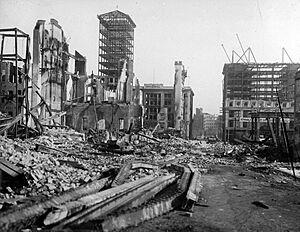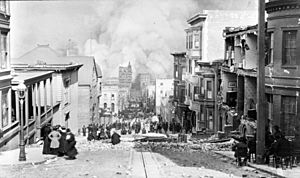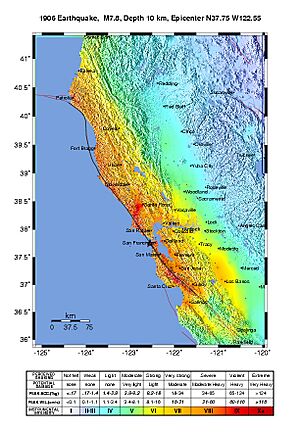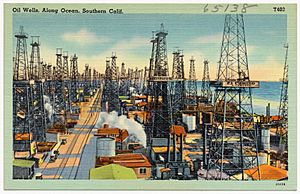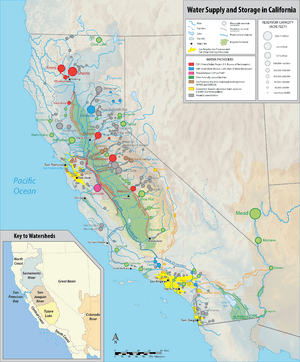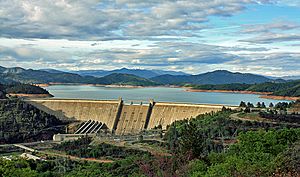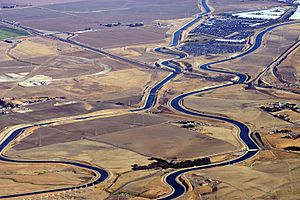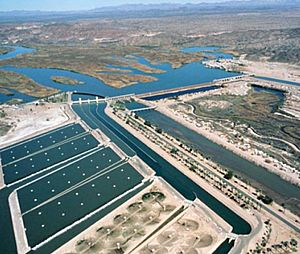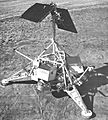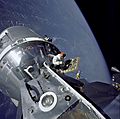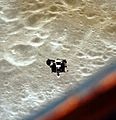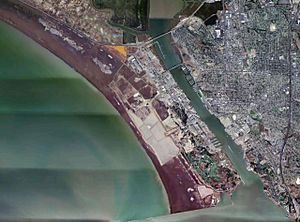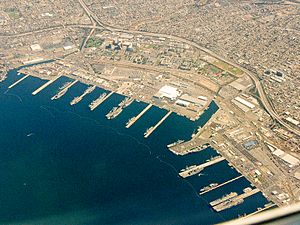History of California (1900–present) facts for kids
California kept growing super fast after 1900. It quickly became a powerhouse in farming and industry. The state's economy was built on special crops, oil, tourism, shipping, movies, and later, cool technology like airplanes and electronics. The famous movies and stars from Hollywood made California known all over the world! Millions of people moved here, chasing the "California Dream" of a better life. Silicon Valley became the global center for computer inventions.
Contents
- California's Growing Population
- California Earthquakes
- California's Oil Industry
- California's Progressive Era
- Organized Labor in California
- California's Water Projects
- California's Highway System
- Movies, Radio, and TV in California
- California's Aerospace and Shipping Industries
- California Naval Bases
- California's Growth After World War II
- California as an Economic Powerhouse
- High-Tech Growth
- California from 2000 to Today
California's Growing Population
| Historical population | |||
|---|---|---|---|
| Census | Pop. | %± | |
| 1840 | 8,000 | — | |
| 1850 | 120,000 | 1,400.0% | |
| 1860 | 379,994 | 216.7% | |
| 1870 | 560,247 | 47.4% | |
| 1880 | 864,694 | 54.3% | |
| 1890 | 1,213,398 | 40.3% | |
| 1900 | 1,485,053 | 22.4% | |
| 1910 | 2,377,549 | 60.1% | |
| 1920 | 3,426,861 | 44.1% | |
| 1930 | 5,677,251 | 65.7% | |
| 1940 | 6,907,387 | 21.7% | |
| 1950 | 10,586,223 | 53.3% | |
| 1960 | 15,717,204 | 48.5% | |
| 1970 | 19,953,134 | 27.0% | |
| 1980 | 23,667,902 | 18.6% | |
| 1990 | 29,760,021 | 25.7% | |
| 2000 | 33,871,648 | 13.8% | |
| 2010 | 37,253,956 | 10.0% | |
| 2020 | 39,538,223 | 6.1% | |
| Sources: 1850–2020 U.S. Census * The 1850 statistics are corrected for lost census data in San Francisco, Santa Clara and Contra Costa Counties. California Indians were not counted before the 1870 census. |
|||
California is now the state with the most people in the United States. If it were its own country, it would be the 34th most populated in the world! Many people have moved to California over the years. The first big wave came during the California Gold Rush in 1848.
In the early 1900s, California's population grew a lot, by over 60% between 1900 and 1910. It more than doubled again by 1930. During the Great Depression, fewer people moved to the U.S., and many foreign workers were sent home because there weren't enough jobs. After World War II and the Great Depression, many U.S. workers moved to California as war industries boomed. By 1950, California's population reached over 10 million people.
California Earthquakes
Earthquakes happen often in California because the state sits on many major fault lines. These are cracks in the Earth's crust. The most famous one is the San Andreas Fault, which runs almost the entire length of California. It's where the Pacific Plate and the North American Plate meet and slide past each other.
Earthquake damage depends on where it hits, how deep it is, and how strong it is. Buildings on soft ground usually get more damaged than those on solid rock. Sometimes, the fires or floods that happen after an earthquake cause even more damage.
The 1906 San Francisco earthquake hit San Francisco and nearby towns at 5:12 a.m. on April 18, 1906. Huge fires broke out and burned for several days, destroying about 28,000 buildings. Over 3,000 people died, and more than 80% of San Francisco was destroyed. This was the biggest loss of life from a natural disaster in California's history.
Scientists believe the earthquake was about a 7.8 on the Richter scale. The shaking was felt from Oregon to Los Angeles. The earthquake was caused by the San Andreas Fault moving. The fault moved about 300 miles (480 km) that day. The most likely spot where the earthquake started was near Mussel Rock in Daly City, just south of San Francisco.
A smaller shake, called a foreshock, happened about 20 to 25 seconds before the main earthquake. The strong shaking of the main earthquake lasted about 42 seconds.
| Important California Earthquakes | ||
|---|---|---|
|
|
||
| Earthquake | Strength | Deaths |
| 1906 San Francisco | 7.8 | 3,000+ |
| 1925 Santa Barbara | 6.3–6.8 | 13 |
| 1933 Long Beach | 6.4 | 115 |
| 1952 Kern County | 7.3 | 12 |
| 1971 San Fernando | 6.6 | 65 |
| 1989 Loma Prieta | 6.9 | 63 |
| 1994 Northridge | 6.7 | 60 |
After the 1906 earthquake, many people blamed the fires for the damage, not the earthquake itself. This was partly because insurance companies often covered fire damage but not earthquake damage. Building rules have been updated many times since 1906 to make buildings safer during earthquakes. However, many older buildings still don't meet today's strict safety standards.
California's Oil Industry
People in California found more and more places where oil was seeping out of the ground after 1848. This happened in many counties, especially in southern California. Interest in oil grew in the 1850s and 1860s after people in Pennsylvania started using oil for business. Kerosene quickly replaced whale oil for lamps, and lubricating oils became very important for machines. Later, oil was used to pave roads and power trains and ships.
Oil became a huge industry in California in the 20th century. New oil fields were found around Los Angeles and in the San Joaquin Valley. There was also a huge demand for gasoline to power the growing number of cars and trucks. In 1900, California produced 4 million barrels of oil. By 1903, California was the top oil-producing state in the U.S. It traded the number one spot with Oklahoma until 1930. By 1910, production reached 78 million barrels. Most oil drilling in California happens in Kern County, the San Joaquin Valley, and the Los Angeles Basin.
In 2012, California was the third biggest oil-producing state in the U.S., after Texas and North Dakota. For a long time, California's oil industry was its biggest export and one of its most profitable businesses.
There is also some oil drilling offshore in California. However, new offshore drilling is not allowed in California waters. These rules were put in place after a series of accidents, like the 1969 Santa Barbara oil spill, released oil into the Pacific Ocean.
| California Oil Production in 2005 | |
|---|---|
|
|
|
| State | Barrels/day |
| Louisiana | 1,463,000 |
| Texas | 1,331,000 |
| Alaska | 894,000 |
| California San Joaquin Valley |
515,000 |
| Oklahoma | 177,000 |
| New Mexico | 171,000 |
By 1920, California's oil production grew to 77 million barrels. Between 1920 and 1930, many new oil fields were found in southern California, like in Huntington Beach and Long Beach. Southern California became a major center for oil production in the United States.
However, all this new oil caused problems. The huge amount of oil from California, Texas, and Oklahoma made oil prices drop very low.
Even after a century, the San Joaquin Valley is still a major oil producer. In 2008, Kern County had over 42,000 oil wells. These wells produced about 68% of California's oil.
Natural Gas Use
In 2020, California was the 14th largest producer of natural gas in the U.S. Natural gas was the second most used energy source in California in 2014. About 45% of it was used to make electricity. Natural gas is better for the environment than coal because it produces less carbon dioxide. About 21% of natural gas was used for heating homes and water, cooking, and drying clothes. California gets about 85% of its natural gas from other states like Texas and New Mexico, and from Canada.
California's Progressive Era
California played a big part in the Progressive Movement, which aimed to fix problems in society and government. It was the only state where Progressives took control of the Republican Party.
Fighting for Change
From the 1890s to the 1920s, California was a leader in the Progressive Movement. A group of reform-minded Republicans, especially in southern California, worked to reduce the political power of the Southern Pacific Railway. In 1910, Hiram Johnson became governor with the slogan "Kick the Southern Pacific out of politics."
Progressives also supported labor unions. Different cities had different concerns. Los Angeles worried about the railroad, alcohol, and unions. San Francisco dealt with a corrupt political system. Smaller cities like San Jose focused on farming cooperatives and city growth.
Women's Rights in California
California women had the right to own property in their own name since the first California Constitution in 1850. In 1911, California voters gave women the right to vote. This was nine years before the 19th Amendment gave women the right to vote across the country in 1920. Women's clubs became popular and focused on issues like public schools, pollution, and public health. California women were also leaders in the temperance movement, which aimed to ban alcohol.
Organized Labor in California
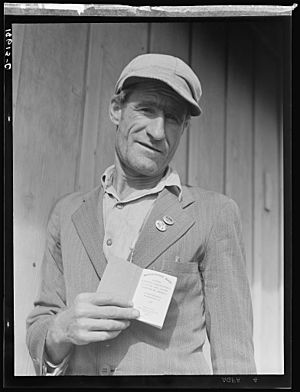
Organized labor, or unions, were very strong in San Francisco early in the state's history. By the early 1900s, unions also grew in Los Angeles and the Central Valley. In 1901, the City Front Federation in San Francisco was considered one of the strongest union groups in the country.
Employers also organized to fight unions. In 1901, a big strike led to the creation of the Union Labor Party. Workers were angry that the mayor used police to protect strikebreakers. Eugene Schmitz was elected mayor of San Francisco in 1902, making it the only city in the U.S. run by a labor party for a while.
In 1910, a bomb exploded at the Los Angeles Times newspaper plant, killing 21 workers. This made it harder for unions to organize in Los Angeles for many years.
The Industrial Workers of the World (IWW), also called Wobblies, grew quickly in jobs that didn't have unions, like logging and farming. They became well-known after the Wheatland Hop Riot, where a protest turned violent and four people died. This led to the first laws protecting farm laborers.
Unions in the 1930s

Unions grew very fast after 1935, thanks to new laws like the Wagner Act of 1935. One of the most serious strikes happened in 1934 along California's ports. Dock workers and longshoremen went on strike for better hours, pay, and union rights.
On "Bloody Thursday," July 5, 1934, there was violent rioting in San Francisco. Striking workers fought with police, and two workers were killed. The strike lasted 83 days, but it ended with a victory for the workers and unions for all West Coast ports.
By the late 1930s, San Francisco had 120,000 union members. Los Angeles also saw a big increase in union members, especially in industries like aircraft, auto, rubber, and oil.
Farm Workers and the "Okies"
Farm work remained very hard and low-paying. In the 1930s, 200,000 farm laborers traveled the state, following the seasons. Unions tried to organize these workers, but many towns passed laws against picketing.
A big political fight happened in 1938 over "Proposition #1," which was against picketing. It failed, and soon, California unions started to accept non-white members.
By the start of World War II, California had laws for old-age help, unemployment compensation, a 48-hour work week for women, and workplace safety rules.
"Okies" were about 250,000 people who moved to California in the 1930s. They fled the Dust Bowl and the Great Depression in Oklahoma and nearby states, hoping for a better life. Many looked for farm jobs in the Central Valley. They were often treated badly. Police even tried to stop them at the Arizona border, but the U.S. Supreme Court said that was illegal.
Most Okies eventually moved into good jobs in war industries in the 1940s. Their children and grandchildren usually stayed in California, living in cities and suburbs. They brought with them a strong sense of evangelical Protestantism, a love for country music, and traditional values.
California's Water Projects
California needs a lot of water to support its large population and farms. Most of California's water comes from snow in the Sierra Nevada mountains in the northern part of the state during winter. The rest of the year usually has very little rain or snow. California also has long periods of drought.
Since before 1900, California has built huge water projects. These projects cost billions of dollars to store and move water where it's needed.
Los Angeles Aqueduct
The Los Angeles Aqueduct carries water from the Owens Valley, through the Mojave Desert, all the way to dry Los Angeles in the south. The project started in 1905. Construction began in 1908 and finished in 1913, employing 5,000 workers.
The aqueduct uses gravity to move water and create electricity, which makes it cheap to run. It was designed by engineer William Mulholland and is still used today.
Hetch Hetchy Project
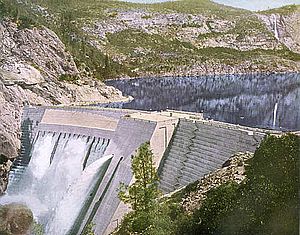
Hetch Hetchy is a valley in Yosemite National Park. After the terrible 1906 San Francisco earthquake and fire, San Francisco needed a new water supply. They chose the Tuolumne River in Hetch Hetchy. In 1913, the U.S. Congress allowed a dam and water system to be built inside part of Yosemite National Park.
The main dam, called the O'Shaughnessy Dam, was finished in 1923. It created the Hetch Hetchy Reservoir. This huge project included miles of tunnels and a 150-mile (240 km) aqueduct to bring water and electricity to San Francisco and the Bay Area.
Central Valley Project

The Central Valley Project (CVP) is a big plan to move water from the Trinity River in northern California to the Sacramento River to help with water supplies. Trinity Dam was built to store water from the Trinity River. By 1963, Trinity Lake was full, becoming the third largest lake in California.
Shasta Dam is a huge concrete dam across the Sacramento River in northern California. It helps store water and control floods in its large reservoir, Shasta Lake. Water from the lake is used to generate hydroelectricity. At 602 feet (183 m) high, it's one of the tallest dams in the U.S. and forms California's largest reservoir.
Shasta Dam was planned as early as 1919 because of frequent floods and droughts in California's largest farming area, the Central Valley. Construction started in 1937 and finished in 1945. It provided thousands of jobs during the Great Depression. Shasta Dam was very important during World War II, providing electricity for factories. It still plays a key role in managing California's water.
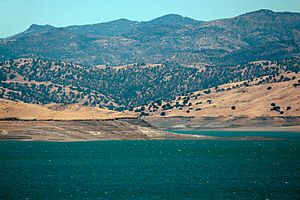
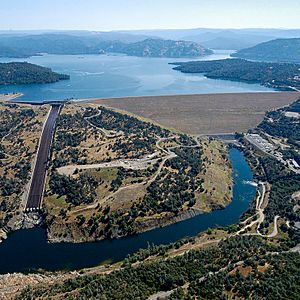
The California Aqueduct is a system of canals, tunnels, and pipelines. It moves water from the Sierra Nevada mountains in northern California to southern California. The California Department of Water Resources manages it. It's the world's largest publicly built water and power system. It provides drinking water for over 23 million people and generates electricity.
About 70% of the water from this project goes to cities and industries in southern California and the San Francisco Bay Area. The other 30% is used for irrigation on farms in the Central Valley. To reach southern California, the water has to be pumped 2,000 feet (610 m) over the Tehachapi Mountains. This is the highest single water lift in the world!
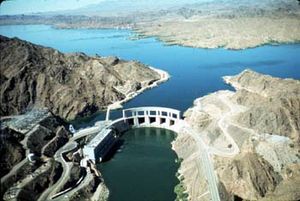

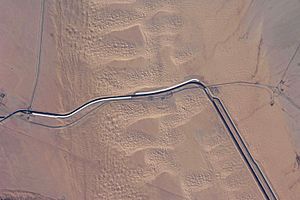
The Colorado River Aqueduct (CRA) is a 242-mile (389 km) water system in southern California. It takes water from the Colorado River at Lake Havasu on the California–Arizona border. This water is then pumped across the Mojave and Colorado deserts to southern California. It's one of the main sources of drinking water for the area.
This was the biggest public works project in southern California during the Great Depression. It employed 30,000 people over eight years. The system includes two reservoirs, five pumping stations, and many canals, tunnels, and pipelines.
Water Recycling and Desalination
California is also working hard to recycle treated wastewater. In 2009, over 770,000 acre-feet of water were recycled. This recycled water is used for things like watering golf courses, landscapes, and farms. It's also used to stop seawater from getting into groundwater.
The Water Replenishment District of Southern California (WRD) uses recycled water to refill groundwater and create barriers against seawater. They treat wastewater to a very high level of purity, even better than average drinking water.
California is also building desalination plants, which remove salt from seawater to make it drinkable. The Claude "Bud" Lewis Carlsbad Desalination Plant is the largest seawater desalination plant in the Western Hemisphere. It's expected to produce about 56,000 acre-feet of water per year by 2016. This helps provide a reliable water source, especially during droughts.
California's Highway System
Cars became important after 1910. Before that, most long-distance travel was by train or stagecoach. The Lincoln Highway, America's first road for cars, connected New York City to San Francisco in 1913. This helped California's industries and tourism grow. The same happened with Route 66 in 1926.
The first state road was created in 1895. In 1912, construction began on a large connected system of highways after voters approved $18 million for over 3,000 miles (4,800 km) of roads.
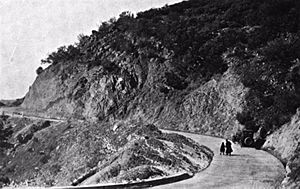
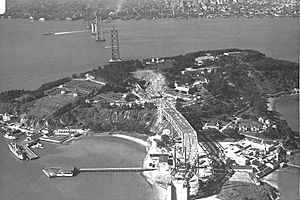
In 1923, a 2-cent per gallon gasoline tax was approved to pay for roads. The California Toll Bridge Authority was created in 1929 to manage toll bridges like the San Francisco–Oakland Bay Bridge. By 1933, the total length of state highways almost doubled to about 14,000 miles (23,000 km).
Movies, Radio, and TV in California
The early 1900s saw the rise of the film studio system. Big studios like MGM, Universal, and Warner Bros. bought land in Hollywood, which was a small area outside Los Angeles. The sunny weather and varied landscapes made filmmaking easier and cheaper. Actors, producers, and other talented people flocked to Hollywood.
Movies made California even more famous, attracting hundreds of thousands of people, especially from the Midwest. They loved the mild weather, cheap land, and new jobs.
By the 1930s, Hollywood also became big in radio. By 1950, southern California was a major center for television production, with studios for networks like NBC and CBS.
California's Aerospace and Shipping Industries
Aerospace History
In the late 1800s, John Joseph Montgomery experimented with gliders and made the first controlled flights in a heavier-than-air machine in America. After the Wright brothers showed that controlled flight was possible, Glenn Curtiss started building aircraft and training pilots in California.
The Los Angeles International Air Meet was one of the first air shows in the world. It attracted about 254,000 people. In 1910, Glenn Curtiss also started a flying school in San Diego, which is now known as "The Birthplace of Naval Aviation."
Caltech in Pasadena became a key place for aircraft development. In 1925, aircraft builder Donald Douglas worked with Caltech to create a top-notch aeronautical research lab. Douglas used the lab's wind tunnel to design his famous planes like the DC-3.
The Jet Propulsion Laboratory (JPL) started at Caltech in 1936, experimenting with rockets. During World War II, JPL developed missiles for the Army. In 1958, JPL launched America's first satellite, Explorer 1. JPL later became NASA's main center for planetary spacecraft, designing missions to the Moon and other planets like Venus and Mars.
During World War II, California became a major center for aircraft manufacturing. Companies like Douglas Aircraft Company and Hughes Aircraft expanded their factories. After the war, many jobs were lost as military orders ended.
California's Famous Aircraft
-
Montgomery's The Santa Clara glider 1905
-
Douglas DC-3 1936
-
Bell X-1 1946
-
Douglas DC-8 1958
-
Lockheed U-2 1957
-
Douglas A-4 Skyhawk 1966
-
Apollo 9 1969
-
Apollo 10 1969
-
Apollo 11 1969
-
Apollo 15 1970
-
Rockwell B-1 Lancer 1974
-
Space Shuttle 1981
-
Lockheed F-117 Nighthawk stealth bomber 1985
California's Shipping Industry

During World War II, California's mild climate was a big help for the war effort. Many air-training bases were set up in southern California. Aircraft manufacturers like Douglas Aircraft Company and Hughes Aircraft expanded their factories. Major naval shipyards were built or expanded in San Diego, Long Beach, and Mare Island in San Francisco Bay.
Kaiser Shipyards
The four Richmond Shipyards in Richmond, California, run by Henry J. Kaiser's companies, built more Liberty ships during World War II (747) than any other shipyard in the United States. Liberty ships were chosen because they were simple to build quickly. Ship building was a top priority because German U-boats were sinking many ships.
Kaiser's shipyards were known for building Liberty ships very fast and efficiently. They could assemble a Liberty ship in a little over two weeks! They did this by building large parts of the ship in different areas of the shipyard, then moving them with cranes to be welded together.
In 1945, the shipyards closed down quickly after the war ended. Today, the Rosie the Riveter/World War II Home Front National Historical Park is on the shipyard site. It remembers the important role people on the home front played in winning World War II.
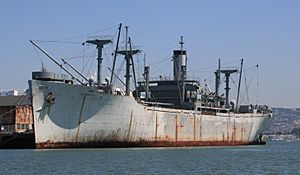
The California Shipbuilding Corporation (Calship) built 467 Liberty and Victory ships during World War II. Their shipyard was at Terminal Island in Los Angeles. After the war, it was closed down.
Mare Island, near Vallejo, was the first naval base in California. In 1854, Mare Island became the first permanent U.S. naval base on the West Coast. David Farragut was its first commander. For over a century, Mare Island was a major naval shipyard.
Before World War II, Mare Island was always growing. By 1941, it had many new buildings and facilities. It employed 18,500 workers by May 1941. During World War II, Mare Island built 32 diesel-powered submarines. After the war, it became a top place for building nuclear-powered submarines, building 27 of them.
Mare Island Naval Shipyard closed in 1996.
Naval Base San Diego started in 1920. It's the largest U.S. Navy base on the West Coast. It's the main homeport for the Pacific Fleet, with 54 ships and many other commands. The base has 13 piers and covers a large area of land and water. Over 20,000 military personnel and 6,000 civilians work there. San Diego is now home to the largest naval fleet in the world.
California's Growth After World War II
After World War II, many land developers bought cheap land, built homes, and became rich. Real estate development became the main industry in southern California. In 1955, Disneyland opened in Anaheim. In 1958, Major League Baseball teams, the Dodgers and Giants, moved to Los Angeles and San Francisco. California's population grew a lot, reaching almost 20 million by 1970.
In the late 1960s, many young people protested the Vietnam War. There were many demonstrations, especially at the Berkeley campus. In 1965, race riots happened in Watts, Los Angeles. The "hippie" movement grew, and San Francisco became famous for its tolerance. This time, known as the Summer of Love in 1967, created a unique Californian culture.
California's growth after World War II was also helped by the arms race with the Soviet Union and the growing defense industry. In 1962, about 40% of the nation's military research money went to California for testing new technology like planes and bombs.
California as an Economic Powerhouse
California also saw huge growth in business and industry. The California Master Plan for Higher Education in 1960 helped create a great public education system, including community colleges and the University of California and California State University systems. This educated workforce attracted investments, especially in high technology. By 1980, California was the world's eighth-largest economy.
This high population caused problems like urban sprawl, traffic, and pollution. Many areas started limiting growth to protect open spaces. Open space districts were created to buy and preserve undeveloped land, creating large natural parks.
The huge problem with air pollution (smog) in the early 1970s led to changes. Schools sometimes closed on "smog days" because the air was too unhealthy. Over the next 30 years, California created some of the strictest anti-smog rules in the U.S. It also encouraged cleaner ways for industries, including cars. For example, electric cars can use carpool lanes even with only one person. As a result, smog has been greatly reduced.
Traffic is still a problem in cities. Solutions are being tried, like more carpool lanes and light rail systems. However, it's hard to keep up with the growing population.
In the 1960s, the California Supreme Court became more liberal. It was the first state to allow "no-fault divorce" in 1969. In 2008, California became the second state to allow same-sex marriage.
Since the mid-1980s, the California Supreme Court has become more conservative.
High-Tech Growth
Starting in the 1950s, high-tech companies in northern California began to grow incredibly fast. They made products like personal computers, video games, and networking systems. Most of these companies settled in the Santa Clara Valley, which became known as "Silicon Valley" because of the silicon used in computer chips.
This era peaked in 2000. There was such a high demand for skilled tech workers that companies had trouble finding enough people. When the "Dot-com bubble" burst in 2001, many jobs disappeared. For the first time in years, more people moved out of the area than moved in.
California from 2000 to Today
Even though air pollution has been reduced, health problems from pollution still exist. The brown haze called "smog" is much better now because of state and federal rules on car exhaust.
An energy crisis in 2001 caused power outages and high electricity prices.
Housing Market Changes
The demand for educated workers continued. Housing prices in cities kept going up. A modest home that cost $25,000 in the 1960s could cost half a million dollars or more by 2005. People started commuting longer distances to afford homes. Some people bought houses just to sell them quickly for a profit. But the housing market crashed in 2007-2008. Housing prices fell, and many people lost their homes.
In the 2002 election, Gray Davis was governor. But in 2003, voters decided to remove him from office. Arnold Schwarzenegger was then chosen as the new governor.
Schwarzenegger started with high approval. He tried to change California's budget system and other things, but he faced challenges from the Democratic-controlled Assembly and Senate. His approval rating went down. He was re-elected in 2006, but problems in state government continued.
Religion in California
In 2014, a survey showed that 63% of Californians were Christian, with 28% Catholic and 20% Evangelical Protestant. About 9% followed non-Christian faiths, and 28% said they were not affiliated with any religion.
COVID-19 Pandemic Impact
One of the first confirmed COVID-19 cases in the U.S. was in California on January 26, 2020. Early cases were people who had recently traveled from China. On March 4, 2020, a state of emergency was declared in California. A statewide stay-at-home order was issued on March 19, 2020, to help stop the spread of the virus. This order ended on January 25, 2021. On April 6, 2021, the state announced plans to fully reopen its economy by June 15, 2021.
|


